Solving Equations
What is an equation.
An equation says that two things are equal. It will have an equals sign "=" like this:
That equations says:
what is on the left (x − 2) equals what is on the right (4)
So an equation is like a statement " this equals that "

What is a Solution?
A Solution is a value we can put in place of a variable (such as x ) that makes the equation true .
Example: x − 2 = 4
When we put 6 in place of x we get:
which is true
So x = 6 is a solution.
How about other values for x ?
- For x=5 we get "5−2=4" which is not true , so x=5 is not a solution .
- For x=9 we get "9−2=4" which is not true , so x=9 is not a solution .
In this case x = 6 is the only solution.
You might like to practice solving some animated equations .
More Than One Solution
There can be more than one solution.
Example: (x−3)(x−2) = 0
When x is 3 we get:
(3−3)(3−2) = 0 × 1 = 0
And when x is 2 we get:
(2−3)(2−2) = (−1) × 0 = 0
which is also true
So the solutions are:
x = 3 , or x = 2
When we gather all solutions together it is called a Solution Set
The above solution set is: {2, 3}
Solutions Everywhere!
Some equations are true for all allowed values and are then called Identities
Example: sin(−θ) = −sin(θ) is one of the Trigonometric Identities
Let's try θ = 30°:
sin(−30°) = −0.5 and
−sin(30°) = −0.5
So it is true for θ = 30°
Let's try θ = 90°:
sin(−90°) = −1 and
−sin(90°) = −1
So it is also true for θ = 90°
Is it true for all values of θ ? Try some values for yourself!
How to Solve an Equation
There is no "one perfect way" to solve all equations.
A Useful Goal
But we often get success when our goal is to end up with:
x = something
In other words, we want to move everything except "x" (or whatever name the variable has) over to the right hand side.
Example: Solve 3x−6 = 9
Now we have x = something ,
and a short calculation reveals that x = 5
Like a Puzzle
In fact, solving an equation is just like solving a puzzle. And like puzzles, there are things we can (and cannot) do.
Here are some things we can do:
- Add or Subtract the same value from both sides
- Clear out any fractions by Multiplying every term by the bottom parts
- Divide every term by the same nonzero value
- Combine Like Terms
- Expanding (the opposite of factoring) may also help
- Recognizing a pattern, such as the difference of squares
- Sometimes we can apply a function to both sides (e.g. square both sides)
Example: Solve √(x/2) = 3
And the more "tricks" and techniques you learn the better you will get.
Special Equations
There are special ways of solving some types of equations. Learn how to ...
- solve Quadratic Equations
- solve Radical Equations
- solve Equations with Sine, Cosine and Tangent
Check Your Solutions
You should always check that your "solution" really is a solution.
How To Check
Take the solution(s) and put them in the original equation to see if they really work.
Example: solve for x:
2x x − 3 + 3 = 6 x − 3 (x≠3)
We have said x≠3 to avoid a division by zero.
Let's multiply through by (x − 3) :
2x + 3(x−3) = 6
Bring the 6 to the left:
2x + 3(x−3) − 6 = 0
Expand and solve:
2x + 3x − 9 − 6 = 0
5x − 15 = 0
5(x − 3) = 0
Which can be solved by having x=3
Let us check x=3 using the original question:
2 × 3 3 − 3 + 3 = 6 3 − 3
Hang On: 3 − 3 = 0 That means dividing by Zero!
And anyway, we said at the top that x≠3 , so ...
x = 3 does not actually work, and so:
There is No Solution!
That was interesting ... we thought we had found a solution, but when we looked back at the question we found it wasn't allowed!
This gives us a moral lesson:
"Solving" only gives us possible solutions, they need to be checked!
- Note down where an expression is not defined (due to a division by zero, the square root of a negative number, or some other reason)
- Show all the steps , so it can be checked later (by you or someone else)

Get step-by-step solutions to your math problems

Try Math Solver

Get step-by-step explanations

Graph your math problems

Practice, practice, practice

Get math help in your language
Math Solver
Geogebra math solver.
Get accurate solutions and step-by-step explanations for algebra and other math problems, while enhancing your problem-solving skills!

Equation Solver
What do you want to calculate.
- Solve for Variable
- Practice Mode
- Step-By-Step
Solver Title
Generating PDF...
- Pre Algebra Order of Operations Factors & Primes Fractions Long Arithmetic Decimals Exponents & Radicals Ratios & Proportions Percent Modulo Number Line Expanded Form Mean, Median & Mode
- Algebra Equations Inequalities System of Equations System of Inequalities Basic Operations Algebraic Properties Partial Fractions Polynomials Rational Expressions Sequences Power Sums Interval Notation Pi (Product) Notation Induction Logical Sets Word Problems
- Pre Calculus Equations Inequalities Scientific Calculator Scientific Notation Arithmetics Complex Numbers Polar/Cartesian Simultaneous Equations System of Inequalities Polynomials Rationales Functions Arithmetic & Comp. Coordinate Geometry Plane Geometry Solid Geometry Conic Sections Trigonometry
- Calculus Derivatives Derivative Applications Limits Integrals Integral Applications Integral Approximation Series ODE Multivariable Calculus Laplace Transform Taylor/Maclaurin Series Fourier Series Fourier Transform
- Functions Line Equations Functions Arithmetic & Comp. Conic Sections Transformation
- Linear Algebra Matrices Vectors
- Trigonometry Identities Proving Identities Trig Equations Trig Inequalities Evaluate Functions Simplify
- Statistics Mean Geometric Mean Quadratic Mean Average Median Mode Order Minimum Maximum Probability Mid-Range Range Standard Deviation Variance Lower Quartile Upper Quartile Interquartile Range Midhinge Standard Normal Distribution
- Physics Mechanics
- Chemistry Chemical Reactions Chemical Properties
- Finance Simple Interest Compound Interest Present Value Future Value
- Economics Point of Diminishing Return
- Conversions Roman Numerals Radical to Exponent Exponent to Radical To Fraction To Decimal To Mixed Number To Improper Fraction Radians to Degrees Degrees to Radians Hexadecimal Scientific Notation Distance Weight Time Volume
- Pre Algebra
- One-Step Addition
- One-Step Subtraction
- One-Step Multiplication
- One-Step Division
- One-Step Decimals
- Two-Step Integers
- Two-Step Add/Subtract
- Two-Step Multiply/Divide
- Two-Step Fractions
- Two-Step Decimals
- Multi-Step Integers
- Multi-Step with Parentheses
- Multi-Step Rational
- Multi-Step Fractions
- Multi-Step Decimals
- Solve by Factoring
- Completing the Square
- Quadratic Formula
- Biquadratic
- Logarithmic
- Exponential
- Rational Roots
- Floor/Ceiling
- Equation Given Roots
- Newton Raphson
- Substitution
- Elimination
- Cramer's Rule
- Gaussian Elimination
- System of Inequalities
- Perfect Squares
- Difference of Squares
- Difference of Cubes
- Sum of Cubes
- Polynomials
- Distributive Property
- FOIL method
- Perfect Cubes
- Binomial Expansion
- Negative Rule
- Product Rule
- Quotient Rule
- Expand Power Rule
- Fraction Exponent
- Exponent Rules
- Exponential Form
- Logarithmic Form
- Absolute Value
- Rational Number
- Powers of i
- Complex Form
- Partial Fractions
- Is Polynomial
- Leading Coefficient
- Leading Term
- Standard Form
- Complete the Square
- Synthetic Division
- Linear Factors
- Rationalize Denominator
- Rationalize Numerator
- Identify Type
- Convergence
- Interval Notation
- Pi (Product) Notation
- Boolean Algebra
- Truth Table
- Mutual Exclusive
- Cardinality
- Caretesian Product
- Age Problems
- Distance Problems
- Cost Problems
- Investment Problems
- Number Problems
- Percent Problems
- Addition/Subtraction
- Multiplication/Division
- Dice Problems
- Coin Problems
- Card Problems
- Pre Calculus
- Linear Algebra
- Trigonometry
- Conversions

Most Used Actions
Number line.
- x^4-5x^2+4=0
- \sqrt{x-1}-x=-7
- \left|3x+1\right|=4
- \log _2(x+1)=\log _3(27)
- 3^x=9^{x+5}
- What is the completing square method?
- Completing the square method is a technique for find the solutions of a quadratic equation of the form ax^2 + bx + c = 0. This method involves completing the square of the quadratic expression to the form (x + d)^2 = e, where d and e are constants.
- What is the golden rule for solving equations?
- The golden rule for solving equations is to keep both sides of the equation balanced so that they are always equal.
- How do you simplify equations?
- To simplify equations, combine like terms, remove parethesis, use the order of operations.
- How do you solve linear equations?
- To solve a linear equation, get the variable on one side of the equation by using inverse operations.
equation-calculator
- High School Math Solutions – Quadratic Equations Calculator, Part 1 A quadratic equation is a second degree polynomial having the general form ax^2 + bx + c = 0, where a, b, and c...
Please add a message.
Message received. Thanks for the feedback.
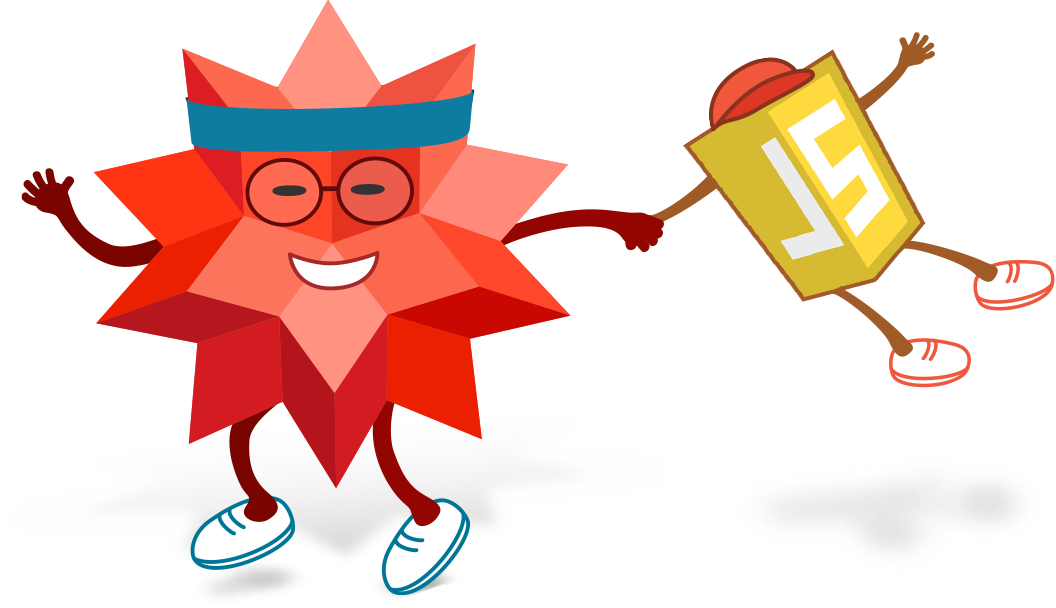
Online Equation Solver
Solve linear, quadratic and polynomial systems of equations with wolfram|alpha.
- Natural Language
More than just an online equation solver
Wolfram|Alpha is a great tool for finding polynomial roots and solving systems of equations. It also factors polynomials, plots polynomial solution sets and inequalities and more.
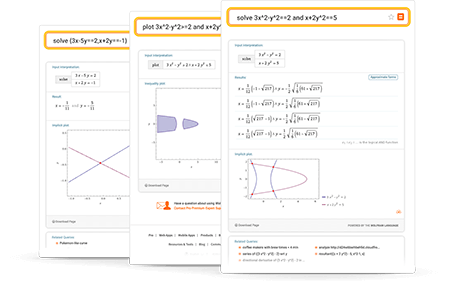
Learn more about:
- Equation solving
Tips for entering queries
Enter your queries using plain English. To avoid ambiguous queries, make sure to use parentheses where necessary. Here are some examples illustrating how to formulate queries.
- find roots to quadratic x^2-7x+12
- plot inequality x^2-7x+12<=0
- solve {3x-5y==2,x+2y==-1}
- plot inequality 3x-5y>=2 and x+2y<=-1
- solve 3x^2-y^2==2 and x+2y^2==5
- plot 3x^2-y^2>=2 and x+2y^2<=5
- View more examples
Access instant learning tools
Get immediate feedback and guidance with step-by-step solutions and Wolfram Problem Generator

- Step-by-step solutions
- Wolfram Problem Generator
About solving equations
A value is said to be a root of a polynomial if ..
The largest exponent of appearing in is called the degree of . If has degree , then it is well known that there are roots, once one takes into account multiplicity. To understand what is meant by multiplicity, take, for example, . This polynomial is considered to have two roots, both equal to 3.
One learns about the "factor theorem," typically in a second course on algebra, as a way to find all roots that are rational numbers. One also learns how to find roots of all quadratic polynomials, using square roots (arising from the discriminant) when necessary. There are more advanced formulas for expressing roots of cubic and quartic polynomials, and also a number of numeric methods for approximating roots of arbitrary polynomials. These use methods from complex analysis as well as sophisticated numerical algorithms, and indeed, this is an area of ongoing research and development.
Systems of linear equations are often solved using Gaussian elimination or related methods. This too is typically encountered in secondary or college math curricula. More advanced methods are needed to find roots of simultaneous systems of nonlinear equations. Similar remarks hold for working with systems of inequalities: the linear case can be handled using methods covered in linear algebra courses, whereas higher-degree polynomial systems typically require more sophisticated computational tools.
How Wolfram|Alpha solves equations
For equation solving, Wolfram|Alpha calls the Wolfram Language's Solve and Reduce functions, which contain a broad range of methods for all kinds of algebra, from basic linear and quadratic equations to multivariate nonlinear systems. In some cases, linear algebra methods such as Gaussian elimination are used, with optimizations to increase speed and reliability. Other operations rely on theorems and algorithms from number theory, abstract algebra and other advanced fields to compute results. These methods are carefully designed and chosen to enable Wolfram|Alpha to solve the greatest variety of problems while also minimizing computation time.
Although such methods are useful for direct solutions, it is also important for the system to understand how a human would solve the same problem. As a result, Wolfram|Alpha also has separate algorithms to show algebraic operations step by step using classic techniques that are easy for humans to recognize and follow. This includes elimination, substitution, the quadratic formula, Cramer's rule and many more.
- Solve equations and inequalities
- Simplify expressions
- Factor polynomials
- Graph equations and inequalities
- Advanced solvers
- All solvers
- Arithmetics
- Determinant
- Percentages
- Scientific Notation
- Inequalities
The equations section of QuickMath allows you to solve and plot virtually any equation or system of equations. In most cases, you can find exact solutions to your equations. Even when this is not possible, QuickMath may be able to give you approximate solutions to almost any level of accuracy you require. It also contains a number of special commands for dealing with quadratic equations.
The Solve command can be uses to solve either a single equation for a single unknown from the basic solve page or to simultaneously solve a system of many equations in many unknowns from the advanced solve page . The advanced command allows you to specify whether you want approximate numerical answers as well as exact ones, and how many digits of accuracy (up to 16) you require. It also allows you to eliminate certain variables from the equations.
Go to the Solve page
The Plot command, from the Graphs section, will plot any function of two variables. In order to plot a single function of x, go to the basic equation plotting page , where you can enter the equation and specify the upper and lower limits on x that you want the graph to be plotted for. The advanced plotting page allows you to plot up to 6 equations on the one graph, each with their own color. It also gives you control over such things as whether or not to show the axes, where the axes should be located, what the aspect ratio of the plot should be and what the range of the dependent variable should be. All equations can be given in the explicit y = f(x) form or the implicit g(x,y) = c form.
Go to the Equation Plotting page
The Quadratics page contains 13 separate commands for dealing with the most common questions concerning quadratics. It allows you to : factor a quadratic function (by two different methods); solve a quadratic equation by factoring the quadratic, using the quadratic formula or by completing the square; rewrite a quadratic function in a different form by completing the square; calculate the concavity, x-intercepts, y-intercept, axis of symmetry and vertex of a parabola; plot a parabola; calculate the discriminant of a quadratic equation and use the discriminant to find the number of roots of a quadratic equation. Each command generates a complete and detailed custom-made explanation of all the steps needed to solve the problem.
Go to the Quadratics page
Introduction to Equations
By an equation we mean a mathematical sentence that states that two algebraic expressions are equal. For example, a (b + c) =ab + ac, ab = ba, and x 2 -1 = (x-1)(x+1) are all equations that we have been using. We recall that we defined a variable as a letter that may be replaced by numbers out of a given set, during a given discussion. This specified set of numbers is sometimes called the replacement set. In this chapter we will deal with equations involving variables where the replacement set, unless otherwise specified, is the set of all real numbers for which all the expressions in the equation are defined.
If an equation is true after the variable has been replaced by a specific number, then the number is called a solution of the equation and is said to satisfy it. Obviously, every solution is a member of the replacement set. The real number 3 is a solution of the equation 2x-1 = x+2, since 2*3-1=3+2. while 1 is a solution of the equation (x-1)(x+2) = 0. The set of all solutions of an equation is called the solution set of the equation.
In the first equation above {3} is the solution set, while in the second example {-2,1} is the solution set. We can verify by substitution that each of these numbers is a solution of its respective equation, and we will see later that these are the only solutions.
A conditional equation is an equation that is satisfied by some numbers from its replacement set and not satisfied by others. An identity is an equation that is satisfied by all numbers from its replacement set.
Example 1 Consider the equation 2x-1 = x+2
The replacement set here is the set of all real numbers. The equation is conditional since, for example, 1 is a member of the replacement set but not of the solution set.
Example 2 Consider the equation (x-1)(x+1) =x 2 -1 The replacement set is the set of all real numbers. From our laws of real numbers if a is any real number, then (a-1)(a+1) = a 2 -1 Therefore, every member of the replacement set is also a member of the solution set. Consequently this equation is an identity.

The replacement set for this equation is the set of real numbers except 0, since 1/x and (1- x)/x are not defined for x = 0. If a is any real number in the replacement set, then

Math Topics
More solvers.
- Add Fractions
- Simplify Fractions
Equation Solver
Enter the Equation you want to solve into the editor.
Please ensure that your password is at least 8 characters and contains each of the following:
- a special character: @$#!%*?&

Game Central

- school Campus Bookshelves
- menu_book Bookshelves
- perm_media Learning Objects
- login Login
- how_to_reg Request Instructor Account
- hub Instructor Commons
Margin Size
- Download Page (PDF)
- Download Full Book (PDF)
- Periodic Table
- Physics Constants
- Scientific Calculator
- Reference & Cite
- Tools expand_more
- Readability
selected template will load here
This action is not available.

3.8: Solving more Equations
- Last updated
- Save as PDF
- Page ID 148757

- Carnegie Math Pathways
\( \newcommand{\vecs}[1]{\overset { \scriptstyle \rightharpoonup} {\mathbf{#1}} } \)
\( \newcommand{\vecd}[1]{\overset{-\!-\!\rightharpoonup}{\vphantom{a}\smash {#1}}} \)
\( \newcommand{\id}{\mathrm{id}}\) \( \newcommand{\Span}{\mathrm{span}}\)
( \newcommand{\kernel}{\mathrm{null}\,}\) \( \newcommand{\range}{\mathrm{range}\,}\)
\( \newcommand{\RealPart}{\mathrm{Re}}\) \( \newcommand{\ImaginaryPart}{\mathrm{Im}}\)
\( \newcommand{\Argument}{\mathrm{Arg}}\) \( \newcommand{\norm}[1]{\| #1 \|}\)
\( \newcommand{\inner}[2]{\langle #1, #2 \rangle}\)
\( \newcommand{\Span}{\mathrm{span}}\)
\( \newcommand{\id}{\mathrm{id}}\)
\( \newcommand{\kernel}{\mathrm{null}\,}\)
\( \newcommand{\range}{\mathrm{range}\,}\)
\( \newcommand{\RealPart}{\mathrm{Re}}\)
\( \newcommand{\ImaginaryPart}{\mathrm{Im}}\)
\( \newcommand{\Argument}{\mathrm{Arg}}\)
\( \newcommand{\norm}[1]{\| #1 \|}\)
\( \newcommand{\Span}{\mathrm{span}}\) \( \newcommand{\AA}{\unicode[.8,0]{x212B}}\)
\( \newcommand{\vectorA}[1]{\vec{#1}} % arrow\)
\( \newcommand{\vectorAt}[1]{\vec{\text{#1}}} % arrow\)
\( \newcommand{\vectorB}[1]{\overset { \scriptstyle \rightharpoonup} {\mathbf{#1}} } \)
\( \newcommand{\vectorC}[1]{\textbf{#1}} \)
\( \newcommand{\vectorD}[1]{\overrightarrow{#1}} \)
\( \newcommand{\vectorDt}[1]{\overrightarrow{\text{#1}}} \)
\( \newcommand{\vectE}[1]{\overset{-\!-\!\rightharpoonup}{\vphantom{a}\smash{\mathbf {#1}}}} \)

INTRODUCTION
As you keep taking more advanced math courses in the future, you will keep seeing more operations, procedures, or functions that cancel each other out. Many operations, procedures, or functions come in pairs. Whatever one operation does, the other one will undo.
By now, you are fairly familiar with two pairs of such operations:
- Addition and subtraction
- Multiplication and division
In this collaboration, we will be discussing two more pairs of operations that cancel each other out:
- Squaring a number (or simply multiplying it by itself two times) and finding a square root.
- Cubing a number (or simply multiplying it by itself three times) and finding a cube root.
Similar to what we did in Collaboration 3.6, let’s illustrate it with an example:
- Pick any non-negative number. This example will use 11.
- Next, square the number that you picked. In this example, 11 2 = 121.
- Next, square root the number for the previous step. You can do it by pressing the √ key on your calculator. In my case, \(\sqrt{121}\) = 11. Note : In this collaboration, all examples involve positive numbers, which is why we disregard the negative value.
- 11 is the same number that I started with! This shows how squaring a number and taking a square root of a number cancel each other out.
This is not a coincidence. It works for any numbers and variables. For example,
- \(\sqrt{71^{2}}\) = 71
- \(\sqrt{x^{2}}\) = x
The same applies to cubes and cube roots. Let’s illustrate with an example:
- Pick any number. This example will use 8.
- Next, cube the number that you picked. In my case, 8 3 = 512.
- Next, cube root the number for the previous step. You can do it by pressing the \(\sqrt[3]{x}\) key on your calculator. In my case, \(\sqrt[3]{512}\) = 8.
- 8 is the same number that I started with and so did you! This shows how cubing numbers and taking a cube root of a number cancel each other out.
- \(\sqrt[3]{87.5^{3}}\) = 87.5
- \(\sqrt[3]{T^{3}}\) = T
SPECIFIC OBJECTIVES
By the end of this collaboration, you should understand that
- To solve any equation, one must follow the basic rules of undoing and keeping the equation balanced.
By the end of this collaboration, you should be able to
- Solve linear equations that require simplification before solving.
- Solve for a variable in a linear equation in terms of another variable.
- Solve for a variable in a single-term quadratic equation.
PROBLEM SITUATION: SOLVING EQUATIONS OF DIFFERENT FORMS
Solving equations such as the Widmark equation for blood alcohol content (BAC) and proportional equations for resizing graphics is an important skill. Mathematical models are often constructed to represent real-life situations. Being able to use these equations fully includes being able to solve for various unknown variables in the equation. Below are three scenarios to help you practice and enhance your equation-solving skills. With each answer, check that it is reasonable given the context and check that you have included the correct units with your solution.
(1) Paula has two options for going to school. She can carpool with a friend or take the bus. Her friend estimates that driving will cost 22 cents per mile for gas and 8.2 cents per mile for maintenance of the car. Additionally, there is a $25 parking fee per week at the college. If Paula carpools, she would pay half of these costs. The cost of the carpool can be modeled by the following equation where C is the cost of carpooling per week and m is the total miles driven to school each week:
\[C = \frac{1}{2}(0.082m + 0.22m + 25)\nonumber \]
(a) On your own, take a minute to think about what the 12 represents in the equation above.
(b) In your group, discuss what each term inside the parentheses represents.
(c) In the given formula, 0.082m is the total maintenance costs for m miles and 0.22m is the total gas cost for m miles. Since both terms include the same variable with the same exponent, they can be combined into one term by adding (or subtracting) their coefficients. Discuss in your group how to rewrite the given formula by combining like-terms. In other words, rewrite the given formula to only include one term that represents the cost per mile.
(d) Find the total weekly carpooling cost if the commute to school is seven miles each way and Paula goes to school three times a week. First try this on your own, then discuss as a group when everyone is ready. Round to the nearest cent.
(e) A weekly bus pass costs $22.00 dollars. How many total miles must Paula commute to school each week for the carpool cost to be equal to the bus pass? First try this on your own, then discuss as a group when everyone is ready. Round to the nearest hundredth.
(f) How many trips to school each week must Paula make for the bus pass to be less expensive than carpooling? First try this on your own, then discuss as a group when everyone is ready.
(2) Recall Widmark’s equation for BAC. In the case of the average male who weighs 190 pounds, 24 you can simplify Widmark’s formula to get
\[B = −0.015t + 0.022N\nonumber \]
Forensic scientists often use this equation at the time of an accident to determine how many drinks someone had. In these cases, time (t) and BAC (B) are known from the police report. The crime lab uses this equation to estimate the number of drinks (N).
(a) Find the number of drinks if the BAC is 0.09 and the time is two hours. First try this on your own, then discuss as a group when everyone is ready. Round to the nearest drink.
(b) Since forensic scientists use the formula to solve for N, it is easier if the formula is rewritten so that it actually solves for N. In the space below, solve for N in terms of t and B. In other words, rewrite the equation so N is isolated on one side of the equation and all other terms are on the other side. First try this on your own, then discuss as a group when everyone is ready.
(c) Use the new formula to find the number of drinks if the BAC is 0.17 and the time is 1.5 hours. First try this on your own, then discuss as a group when everyone is ready. Round to the nearest drink.
(3) You volunteer for a nonprofit organization interested in women’s issues. The logo for your nonprofit organization is three identical squares arranged as follows:
(a) The organization wants to make banners of different sizes. Find an equation that can be used to find the total area of the logo based on the length of the side of one of the squares. First try this on your own, then discuss as a group when everyone is ready.
Assume that the 3 squares have the same dimensions.
(b) The organization is sponsoring a walk-a-thon to raise funds for breast cancer research. You want to recreate this logo (forming the three squares) in the middle of the racetrack with bras that have been collected at multiple drop-off sites around the city. You estimate that approximately 1,500 square feet of bras have been donated. How long should you make each side of the square? Round to two decimal places.
MAKING CONNECTIONS
Record the important mathematical ideas from the discussion.
___________________________________
24 http://www.cdc.gov/nchs/fastats/body-measurements.htm

Solving Equations Practice Questions
Click here for questions, click here for answers.
equation, solve
GCSE Revision Cards

5-a-day Workbooks

Primary Study Cards

Privacy Policy
Terms and Conditions
Corbettmaths © 2012 – 2024
- Tata Motors share price
- 953.75 0.85%
- Power Grid Corporation Of India share price
- 316.10 0.88%
- ITC share price
- 436.50 -0.02%
- Tata Steel share price
- 167.90 0.39%
- State Bank Of India share price
- 820.35 0.31%
Google Circle to Search can now solve maths problems for students: Here's how the feature works
Google's circle to search focuses on educational support by aiding students in understanding problem-solving techniques, with plans to expand to more complex equations using ai model learnlm..

Tech giant Google has unveiled a significant update to its Circle to Search feature during the annual developer conference, Google I/O. This enhancement aims to empower students by providing assistance with math and physics problems directly from their Android smartphones or tablets.
The revamped Circle to Search now offers a specialized tool tailored to guide students through solving homework problems in mathematics and physics. Unlike merely providing answers, Google emphasizes that the feature is designed to foster a deeper understanding of problem-solving techniques, aiding students in learning how to tackle challenges independently.
Through Circle to Search, students can activate AI-driven assistance for mathematical word problems, which systematically breaks down the problem and provides step-by-step instructions for finding the correct solution. Google underscores that the feature is intended as a supportive educational tool, rather than a shortcut for completing assignments.
This announcement comes amidst ongoing discussions surrounding the integration of AI tools in education, with concerns raised about potential misuse by students seeking to expedite their homework. Google addresses these concerns by positioning Circle to Search as a resource focused on facilitating learning and skill development.
Looking ahead, Google revealed plans to further expand the capabilities of Circle to Search. Soon, the functionality will be upgraded to tackle more intricate mathematical equations, encompassing symbolic formulas, diagrams, and graphs, suggests the American company.
Google will utilize LearnLM , its most recent AI model optimized explicitly for educational tasks, to drive these advanced capabilities.
In a blog post announcing the update, Google stated, "Starting today, Circle to Search can now help students with homework, giving them a deeper understanding, not just an answer — directly from their phones and tablets. When students circle a prompt they’re stuck on, they’ll get step-by-step instructions to solve a range of physics and math word problems without leaving their digital info sheet or syllabus. Later this year, Circle to Search will be able to help solve even more complex problems involving symbolic formulas, diagrams, graphs, and more. This is all possible due to our LearnLM effort to enhance our models and products for learning."
Milestone Alert! Livemint tops charts as the fastest growing news website in the world 🌏 Click here to know more.
Unlock a world of Benefits! From insightful newsletters to real-time stock tracking, breaking news and a personalized newsfeed - it's all here, just a click away! Login Now!
Wait for it…
Log in to our website to save your bookmarks. It'll just take a moment.
You are just one step away from creating your watchlist!
Oops! Looks like you have exceeded the limit to bookmark the image. Remove some to bookmark this image.
Your session has expired, please login again.
Congratulations!
You are now subscribed to our newsletters. In case you can’t find any email from our side, please check the spam folder.

Subscribe to continue
This is a subscriber only feature Subscribe Now to get daily updates on WhatsApp
Open Demat Account and Get Best Offers
Start Investing in Stocks, Mutual Funds, IPOs, and more
- Please enter valid name
- Please enter valid mobile number
- Please enter valid email
- Select Location
I'm interested in opening a Trading and Demat Account and am comfortable with the online account opening process. I'm open to receiving promotional messages through various channels, including calls, emails & SMS.
The team will get in touch with you shortly
If you're seeing this message, it means we're having trouble loading external resources on our website.
If you're behind a web filter, please make sure that the domains *.kastatic.org and *.kasandbox.org are unblocked.
To log in and use all the features of Khan Academy, please enable JavaScript in your browser.
Unit 2: Solving equations with one unknown
About this unit.
Let's take your equation-solving skills to the next level! You'll learn all the strategies you need to confidently tackle problems with variables on both sides, parentheses, and more. Plus, you'll get plenty of practice with word problems to really solidify your understanding.
Equations with variables on both sides
- Intro to equations with variables on both sides (Opens a modal)
- Equations with variables on both sides: 20-7x=6x-6 (Opens a modal)
- Equation with variables on both sides: fractions (Opens a modal)
- Equation with the variable in the denominator (Opens a modal)
- Equations with variables on both sides Get 3 of 4 questions to level up!
- Equations with variables on both sides: decimals & fractions Get 3 of 4 questions to level up!
Equations with parentheses
- Equations with parentheses (Opens a modal)
- Multi-step equations review (Opens a modal)
- Equations with parentheses Get 3 of 4 questions to level up!
- Equations with parentheses: decimals & fractions Get 3 of 4 questions to level up!
Number of solutions to equations
- Number of solutions to equations (Opens a modal)
- Worked example: number of solutions to equations (Opens a modal)
- Creating an equation with no solutions (Opens a modal)
- Creating an equation with infinitely many solutions (Opens a modal)
- Number of solutions to equations Get 3 of 4 questions to level up!
- Number of solutions to equations challenge Get 3 of 4 questions to level up!
Equations word problems
- Sums of consecutive integers (Opens a modal)
- Sum of integers challenge (Opens a modal)
- Solving equations with one unknown: FAQ (Opens a modal)
- Sums of consecutive integers Get 3 of 4 questions to level up!
Watch CBS News
Teens come up with trigonometry proof for Pythagorean Theorem, a problem that stumped math world for centuries
By Bill Whitaker
May 5, 2024 / 7:00 PM EDT / CBS News
As the school year ends, many students will be only too happy to see math classes in their rearview mirrors. It may seem to some of us non-mathematicians that geometry and trigonometry were created by the Greeks as a form of torture, so imagine our amazement when we heard two high school seniors had proved a mathematical puzzle that was thought to be impossible for 2,000 years.
We met Calcea Johnson and Ne'Kiya Jackson at their all-girls Catholic high school in New Orleans. We expected to find two mathematical prodigies.
Instead, we found at St. Mary's Academy , all students are told their possibilities are boundless.
Come Mardi Gras season, New Orleans is alive with colorful parades, replete with floats, and beads, and high school marching bands.
In a city where uniqueness is celebrated, St. Mary's stands out – with young African American women playing trombones and tubas, twirling batons and dancing - doing it all, which defines St. Mary's, students told us.
Junior Christina Blazio says the school instills in them they have the ability to accomplish anything.
Christina Blazio: That is kinda a standard here. So we aim very high - like, our aim is excellence for all students.
The private Catholic elementary and high school sits behind the Sisters of the Holy Family Convent in New Orleans East. The academy was started by an African American nun for young Black women just after the Civil War. The church still supports the school with the help of alumni.
In December 2022, seniors Ne'Kiya Jackson and Calcea Johnson were working on a school-wide math contest that came with a cash prize.
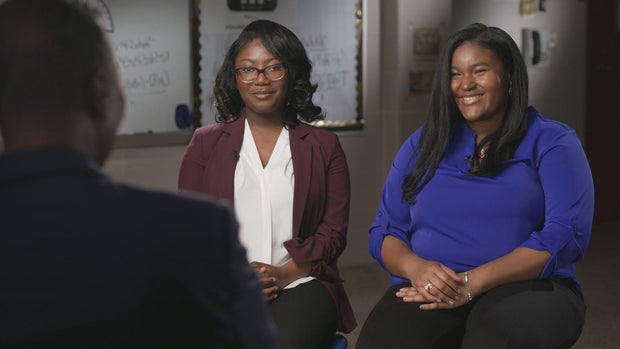
Ne'Kiya Jackson: I was motivated because there was a monetary incentive.
Calcea Johnson: 'Cause I was like, "$500 is a lot of money. So I-- I would like to at least try."
Both were staring down the thorny bonus question.
Bill Whitaker: So tell me, what was this bonus question?
Calcea Johnson: It was to create a new proof of the Pythagorean Theorem. And it kind of gave you a few guidelines on how would you start a proof.
The seniors were familiar with the Pythagorean Theorem, a fundamental principle of geometry. You may remember it from high school: a² + b² = c². In plain English, when you know the length of two sides of a right triangle, you can figure out the length of the third.
Both had studied geometry and some trigonometry, and both told us math was not easy. What no one told them was there had been more than 300 documented proofs of the Pythagorean Theorem using algebra and geometry, but for 2,000 years a proof using trigonometry was thought to be impossible, … and that was the bonus question facing them.
Bill Whitaker: When you looked at the question did you think, "Boy, this is hard"?
Ne'Kiya Jackson: Yeah.
Bill Whitaker: What motivated you to say, "Well, I'm going to try this"?
Calcea Johnson: I think I was like, "I started something. I need to finish it."
Bill Whitaker: So you just kept on going.
Calcea Johnson: Yeah.
For two months that winter, they spent almost all their free time working on the proof.
CeCe Johnson: She was like, "Mom, this is a little bit too much."
CeCe and Cal Johnson are Calcea's parents.
CeCe Johnson: So then I started looking at what she really was doing. And it was pages and pages and pages of, like, over 20 or 30 pages for this one problem.
Cal Johnson: Yeah, the garbage can was full of papers, which she would, you know, work out the problems and-- if that didn't work she would ball it up, throw it in the trash.
Bill Whitaker: Did you look at the problem?
Neliska Jackson is Ne'Kiya's mother.
Neliska Jackson: Personally I did not. 'Cause most of the time I don't understand what she's doing (laughter).
Michelle Blouin Williams: What if we did this, what if I write this? Does this help? ax² plus ….
Their math teacher, Michelle Blouin Williams, initiated the math contest.
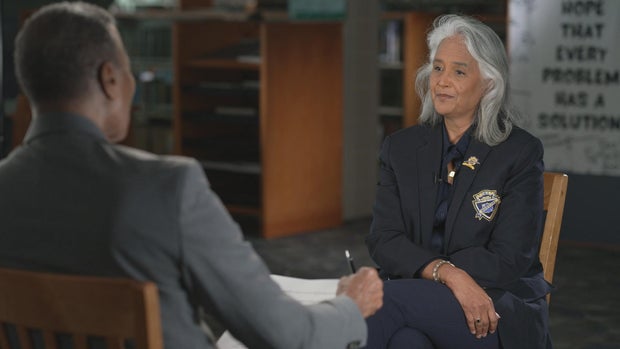
Bill Whitaker: And did you think anyone would solve it?
Michelle Blouin Williams: Well, I wasn't necessarily looking for a solve. So, no, I didn't—
Bill Whitaker: What were you looking for?
Michelle Blouin Williams: I was just looking for some ingenuity, you know—
Calcea and Ne'Kiya delivered on that! They tried to explain their groundbreaking work to 60 Minutes. Calcea's proof is appropriately titled the Waffle Cone.
Calcea Johnson: So to start the proof, we start with just a regular right triangle where the angle in the corner is 90°. And the two angles are alpha and beta.
Bill Whitaker: Uh-huh
Calcea Johnson: So then what we do next is we draw a second congruent, which means they're equal in size. But then we start creating similar but smaller right triangles going in a pattern like this. And then it continues for infinity. And eventually it creates this larger waffle cone shape.
Calcea Johnson: Am I going a little too—
Bill Whitaker: You've been beyond me since the beginning. (laughter)
Bill Whitaker: So how did you figure out the proof?
Ne'Kiya Jackson: Okay. So you have a right triangle, 90° angle, alpha and beta.
Bill Whitaker: Then what did you do?
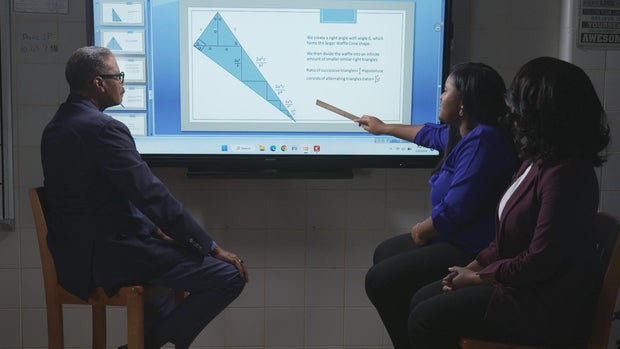
Ne'Kiya Jackson: Okay, I have a right triangle inside of the circle. And I have a perpendicular bisector at OP to divide the triangle to make that small right triangle. And that's basically what I used for the proof. That's the proof.
Bill Whitaker: That's what I call amazing.
Ne'Kiya Jackson: Well, thank you.
There had been one other documented proof of the theorem using trigonometry by mathematician Jason Zimba in 2009 – one in 2,000 years. Now it seems Ne'Kiya and Calcea have joined perhaps the most exclusive club in mathematics.
Bill Whitaker: So you both independently came up with proof that only used trigonometry.
Ne'Kiya Jackson: Yes.
Bill Whitaker: So are you math geniuses?
Calcea Johnson: I think that's a stretch.
Bill Whitaker: If not genius, you're really smart at math.
Ne'Kiya Jackson: Not at all. (laugh)
To document Calcea and Ne'Kiya's work, math teachers at St. Mary's submitted their proofs to an American Mathematical Society conference in Atlanta in March 2023.
Ne'Kiya Jackson: Well, our teacher approached us and was like, "Hey, you might be able to actually present this," I was like, "Are you joking?" But she wasn't. So we went. I got up there. We presented and it went well, and it blew up.
Bill Whitaker: It blew up.
Calcea Johnson: Yeah.
Ne'Kiya Jackson: It blew up.
Bill Whitaker: Yeah. What was the blowup like?
Calcea Johnson: Insane, unexpected, crazy, honestly.
It took millenia to prove, but just a minute for word of their accomplishment to go around the world. They got a write-up in South Korea and a shout-out from former first lady Michelle Obama, a commendation from the governor and keys to the city of New Orleans.
Bill Whitaker: Why do you think so many people found what you did to be so impressive?
Ne'Kiya Jackson: Probably because we're African American, one. And we're also women. So I think-- oh, and our age. Of course our ages probably played a big part.
Bill Whitaker: So you think people were surprised that young African American women, could do such a thing?
Calcea Johnson: Yeah, definitely.
Ne'Kiya Jackson: I'd like to actually be celebrated for what it is. Like, it's a great mathematical achievement.
Achievement, that's a word you hear often around St. Mary's academy. Calcea and Ne'Kiya follow a long line of barrier-breaking graduates.
The late queen of Creole cooking, Leah Chase , was an alum. so was the first African-American female New Orleans police chief, Michelle Woodfork …
And judge for the Fifth Circuit Court of Appeals, Dana Douglas. Math teacher Michelle Blouin Williams told us Calcea and Ne'Kiya are typical St. Mary's students.
Bill Whitaker: They're not unicorns.
Michelle Blouin Williams: Oh, no no. If they are unicorns, then every single lady that has matriculated through this school is a beautiful, Black unicorn.
Pamela Rogers: You're good?
Pamela Rogers, St. Mary's president and interim principal, told us the students hear that message from the moment they walk in the door.

Pamela Rogers: We believe all students can succeed, all students can learn. It does not matter the environment that you live in.
Bill Whitaker: So when word went out that two of your students had solved this almost impossible math problem, were they universally applauded?
Pamela Rogers: In this community, they were greatly applauded. Across the country, there were many naysayers.
Bill Whitaker: What were they saying?
Pamela Rogers: They were saying, "Oh, they could not have done it. African Americans don't have the brains to do it." Of course, we sheltered our girls from that. But we absolutely did not expect it to come in the volume that it came.
Bill Whitaker: And after such a wonderful achievement.
Pamela Rogers: People-- have a vision of who can be successful. And-- to some people, it is not always an African American female. And to us, it's always an African American female.
Gloria Ladson-Billings: What we know is when teachers lay out some expectations that say, "You can do this," kids will work as hard as they can to do it.
Gloria Ladson-Billings, professor emeritus at the University of Wisconsin, has studied how best to teach African American students. She told us an encouraging teacher can change a life.
Bill Whitaker: And what's the difference, say, between having a teacher like that and a whole school dedicated to the excellence of these students?
Gloria Ladson-Billings: So a whole school is almost like being in Heaven.
Bill Whitaker: What do you mean by that?
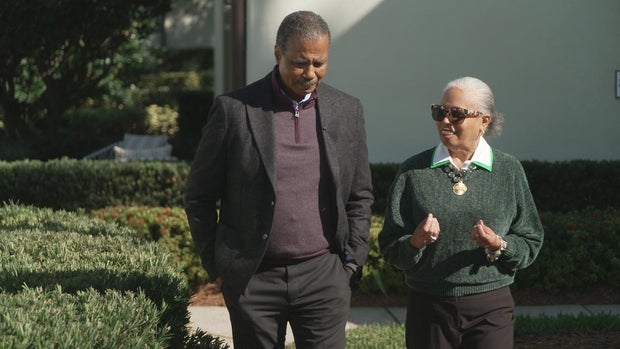
Gloria Ladson-Billings: Many of our young people have their ceilings lowered, that somewhere around fourth or fifth grade, their thoughts are, "I'm not going to be anything special." What I think is probably happening at St. Mary's is young women come in as, perhaps, ninth graders and are told, "Here's what we expect to happen. And here's how we're going to help you get there."
At St. Mary's, half the students get scholarships, subsidized by fundraising to defray the $8,000 a year tuition. Here, there's no test to get in, but expectations are high and rules are strict: no cellphones, modest skirts, hair must be its natural color.
Students Rayah Siddiq, Summer Forde, Carissa Washington, Tatum Williams and Christina Blazio told us they appreciate the rules and rigor.
Rayah Siddiq: Especially the standards that they set for us. They're very high. And I don't think that's ever going to change.
Bill Whitaker: So is there a heart, a philosophy, an essence to St. Mary's?
Summer Forde: The sisterhood—
Carissa Washington: Sisterhood.
Tatum Williams: Sisterhood.
Bill Whitaker: The sisterhood?
Voices: Yes.
Bill Whitaker: And you don't mean the nuns. You mean-- (laughter)
Christina Blazio: I mean, yeah. The community—
Bill Whitaker: So when you're here, there's just no question that you're going to go on to college.
Rayah Siddiq: College is all they talk about. (laughter)
Pamela Rogers: … and Arizona State University (Cheering)
Principal Rogers announces to her 615 students the colleges where every senior has been accepted.
Bill Whitaker: So for 17 years, you've had a 100% graduation rate—
Pamela Rogers: Yes.
Bill Whitaker: --and a 100% college acceptance rate?
Pamela Rogers: That's correct.
Last year when Ne'Kiya and Calcea graduated, all their classmates went to college and got scholarships. Ne'Kiya got a full ride to the pharmacy school at Xavier University in New Orleans. Calcea, the class valedictorian, is studying environmental engineering at Louisiana State University.
Bill Whitaker: So wait a minute. Neither one of you is going to pursue a career in math?
Both: No. (laugh)
Calcea Johnson: I may take up a minor in math. But I don't want that to be my job job.
Ne'Kiya Jackson: Yeah. People might expect too much out of me if (laugh) I become a mathematician. (laugh)
But math is not completely in their rear-view mirrors. This spring they submitted their high school proofs for final peer review and publication … and are still working on further proofs of the Pythagorean Theorem. Since their first two …
Calcea Johnson: We found five. And then we found a general format that could potentially produce at least five additional proofs.
Bill Whitaker: And you're not math geniuses?
Bill Whitaker: I'm not buying it. (laughs)
Produced by Sara Kuzmarov. Associate producer, Mariah B. Campbell. Edited by Daniel J. Glucksman.

Bill Whitaker is an award-winning journalist and 60 Minutes correspondent who has covered major news stories, domestically and across the globe, for more than four decades with CBS News.
More from CBS News

American who disappeared in Syria in 2017 presumed dead, daughter says

Vatican updates norms to evaluate visions of Mary in the internet age

What to know about getting a mortgage after bankruptcy

"CBS News Sunday Morning" gets a makeover by legendary designer David Rockwell
Garbage can regulations are solving Hoboken’s rat crisis, but creating an expensive people problem, 2 councilmembers say
- Updated: May. 16, 2024, 5:15 p.m. |
- Published: May. 14, 2024, 4:59 p.m.
- Mark Koosau | The Jersey Journal
A law established last summer that requires garbage to be stored in sealed containers has helped stabilize Hoboken’s rat problem, but two councilmembers say their constituents are paying the price with expensive tickets for minor slip-ups.
An ordinance, sponsored by Council President Jen Giattino and Councilman Ruben Ramos up for introduction Wednesday, would reduce the penalties for violating the rules for garbage and recycling to either a warning or half of the current, steep fines.
If you purchase a product or register for an account through a link on our site, we may receive compensation. By using this site, you consent to our User Agreement and agree that your clicks, interactions, and personal information may be collected, recorded, and/or stored by us and social media and other third-party partners in accordance with our Privacy Policy.
Featured Topics
Featured series.
A series of random questions answered by Harvard experts.
Explore the Gazette
Read the latest.
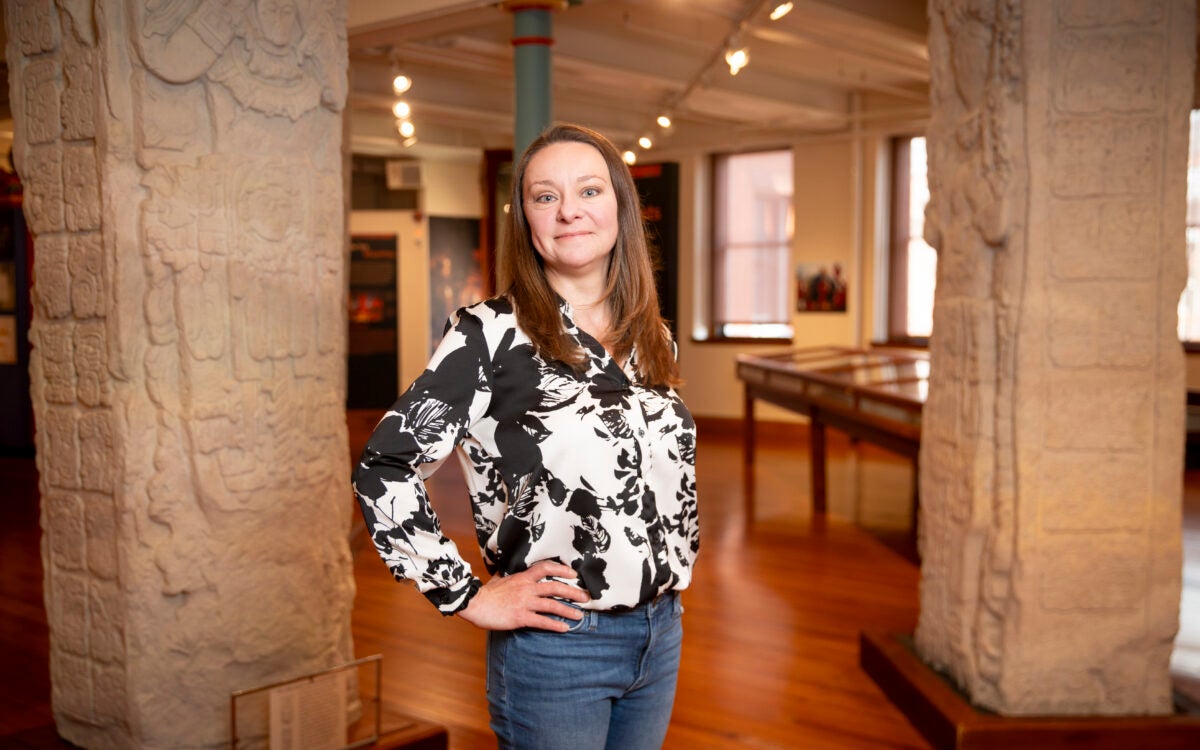
‘I haven’t really had a proper weekend in a long time’

Party like it’s 2020

Study of Psychedelics in Society and Culture announces funding recipients
‘you can solve anything’.
Priyanka Pillai wants to take on big problems — and has learned how good design can help
Christina Pazzanese
Harvard Staff Writer

Niles Singer/Harvard Staff Photographer
Part of the Commencement 2024 series
A collection of stories covering Harvard University’s 373rd Commencement.
Growing up in India, Priyanka Pillai witnessed the immense and varied struggles many impoverished people faced in their daily lives, such as getting prenatal care and protecting children from labor exploitation.
As an undergraduate in Bangalore studying industrial design, she wondered whether good design could help ease at least parts of these and other challenges. She came to Harvard Graduate School of Design two years ago and got her answer, discovering she could take on big problems “that you don’t even realize … could be tackled with design.”
Pillai wanted to do something to help address the refugee crisis in Uganda for her independent design engineering project. Those projects span two semesters and call for students seeking a master’s in design engineering (a joint GSD and John A. Paulson School of Engineering and Applied Sciences program) to identify complex, real-world problems and develop solution prototypes.
“For the first time, I truly felt like I was doing work that was very in touch with what GSD wants people to do, which is working with communities.”
Conducting fieldwork in Uganda, Pillai saw the difficulties that South Sudanese refugees were having reuniting with their families. The plight of those fleeing the ongoing civil war in the northeast African nation has become one of the largest refugee crises in the world, with more than half a million living in Uganda alone, mostly in camps.
More than 60 percent are children separated from parents who are looking for them, Pillai said, and need multiple layers of support. While non-governmental organizations (NGOs) are providing some assistance, much more help is needed.
“One thing that really stood out was agency. There’s currently a lack of agency when it comes to finding their family members on their own,” said Pillai, who graduates later this month. Many refugees use informal, ad hoc methods such as phone calls, WhatsApp, and photo sharing to try to find relatives.
“The second part, which is extremely critical, is that we need to move from a Western-centric way of finding a family member,” such as cataloguing names, ages, and date of separation done by NGOs, because it doesn’t capture vernacularor local geography, vital details that may speed up reunification, she said, noting that learning more about how to design for “the Indian context” and the Global South more generally was a key reason she came to Harvard.
“A lot of cultural nuances were missing in connection to the data to find missing family members,” she said. “And that’s the kind of solution that we’re moving toward.”
Given the ubiquity of cellphones there, Pillai and classmate Julius Stein designed and built an online platform for refugees to enter information about themselves using text, photos, and audio. The platform generates a series of questions that can lead to possible matches while minimizing the risk of exploitation by malign actors.
“For the first time, I truly felt like I was doing work that was very in touch with what GSD wants people to do, which is working with communities,” she said. “It was just a life-changing experience.”
Earlier this month, one startup Pillai is involved in, Alba, won an Ingenuity Award as part of the Harvard President’s Innovation Challenge. The team designed a special wipe so the visually impaired can better detect when their menstrual period has begun without relying on outside assistance.
In 2023, Pillai was part of a student project that won gold in the Spark International Design awards. The design team created Felt, a haptic armband that turns sound and visual clues into movement. The device assists people who are deaf blind to independently catch emotional nuances or subtexts in conversations, which often get lost in Braille or other translations.
During her time in the program, Pillai also jumped at the opportunity to take courses at the Harvard Kennedy School, Harvard Law School, and Harvard Graduate School of Education to learn more about things such as accessibility, ethical design, and negotiation.
“I knew that I was limiting myself because I didn’t know all these different things,” she said.
When not focused on her own studies, Pillai has been a teaching fellow for a design studio at GSD and at SEAS for a course led by her IDEP adviser, Krzysztof Gajos, Gordon McKay Professor of Computer Science.
“I love teaching,” she said. “It’s one of my favorite experiences.”
Reflecting on her time at GSD, Pillai has been deeply inspired by the faculty and her fellow students. This group from many different backgrounds with different interests and perspectives, working in many different disciplines, has been like a “dream” design studio where she’s been able to share and borrow ideas and practices from others and see how other fields look at things such as collaboration, sustainability and accessibility. It has been intellectually liberating to experience such fearlessness, she said, after years of feeling so “constrained” in her prior practice, which had been “rooted in ‘realistic goals.’”
“People tackling very huge issues that you don’t even realize 1) is a problem that could be tackled with design, and 2), they’re almost your age and they’re doing it somehow. That was very important to see,” she said.
“People really think that you can solve anything.”
Share this article
Also in this series:.
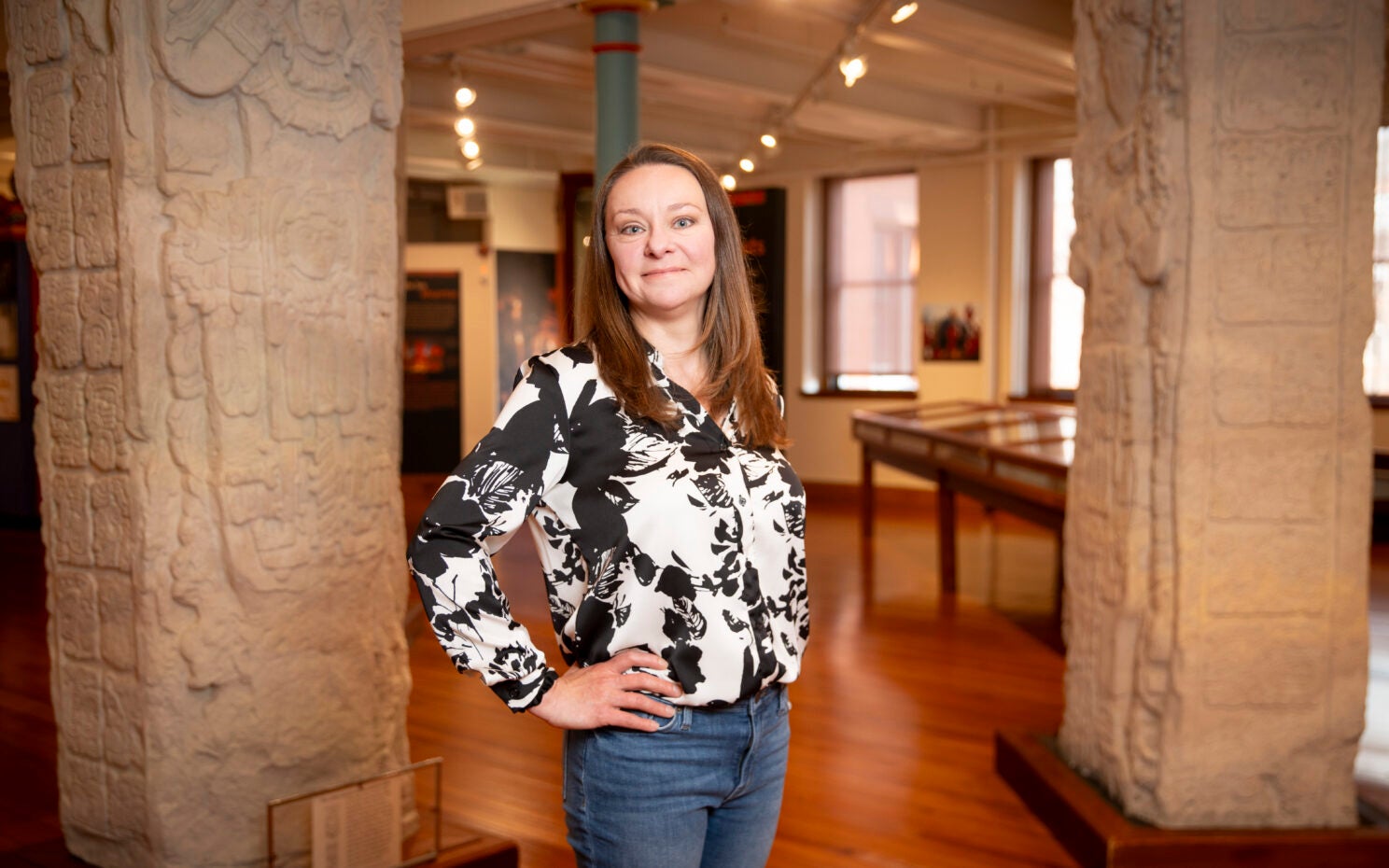
Longtime supporter of grads Kathy Hanley caps 13-year quest with a Commencement of her own

Class of ’24 gets a do-over on high school prom that pandemic took away
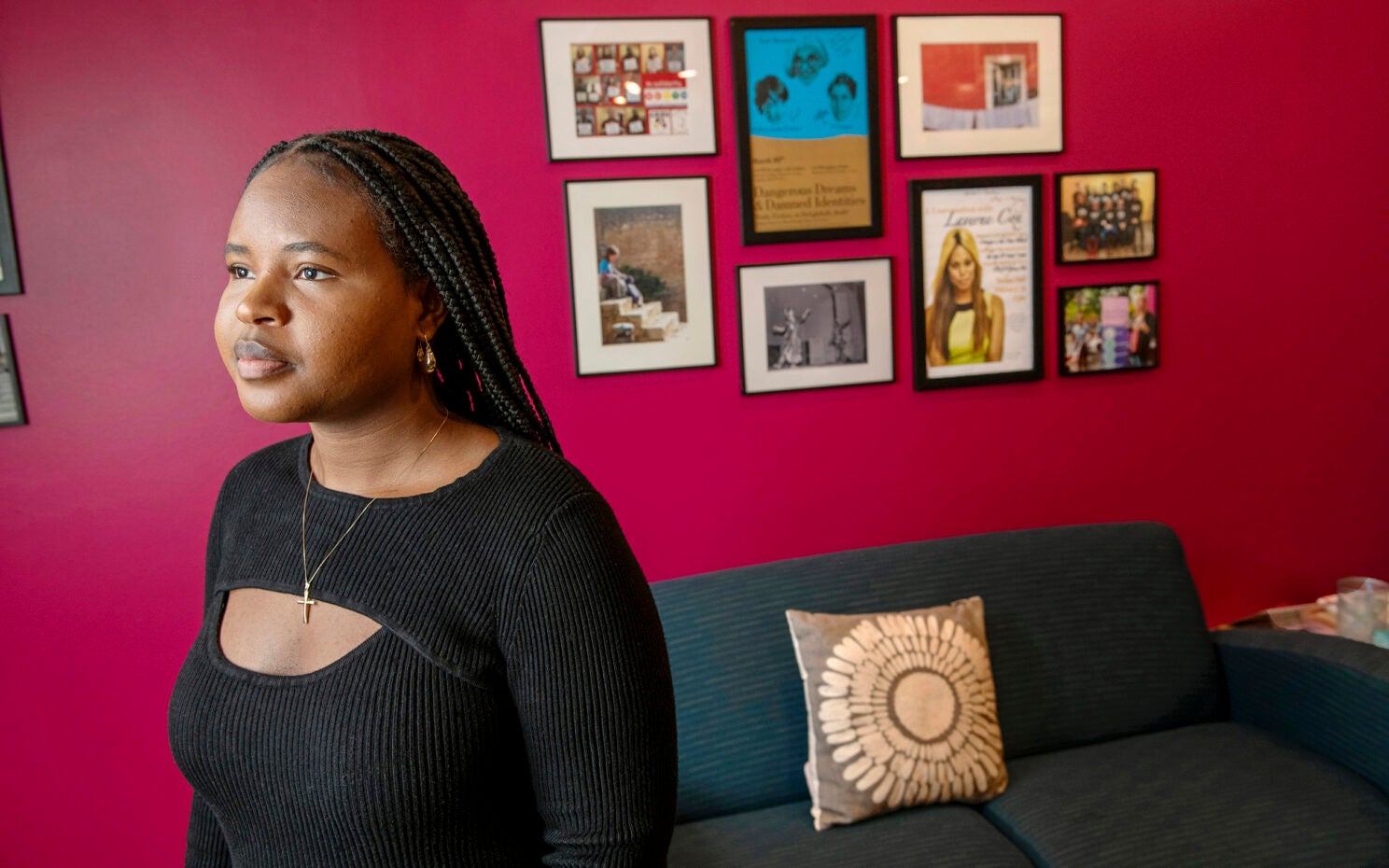
‘I was frustrated, infuriated, because women are just as capable’
Experiences in Uganda and U.S. fuel Ananda Birungi’s passion for empowering others, especially women and girls
You might like

Three major events, including Psychedelics Bootcamp 2024, to be hosted over summer
Epic science inside a cubic millimeter of brain
Researchers publish largest-ever dataset of neural connections
Finding right mix on campus speech policies
Legal, political scholars discuss balancing personal safety, constitutional rights, academic freedom amid roiling protests, cultural shifts
Good genes are nice, but joy is better
Harvard study, almost 80 years old, has proved that embracing community helps us live longer, and be happier
Facility for Rare Isotope Beams
At michigan state university, international research team uses wavefunction matching to solve quantum many-body problems, new approach makes calculations with realistic interactions possible.
FRIB researchers are part of an international research team solving challenging computational problems in quantum physics using a new method called wavefunction matching. The new approach has applications to fields such as nuclear physics, where it is enabling theoretical calculations of atomic nuclei that were previously not possible. The details are published in Nature (“Wavefunction matching for solving quantum many-body problems”) .
Ab initio methods and their computational challenges
An ab initio method describes a complex system by starting from a description of its elementary components and their interactions. For the case of nuclear physics, the elementary components are protons and neutrons. Some key questions that ab initio calculations can help address are the binding energies and properties of atomic nuclei not yet observed and linking nuclear structure to the underlying interactions among protons and neutrons.
Yet, some ab initio methods struggle to produce reliable calculations for systems with complex interactions. One such method is quantum Monte Carlo simulations. In quantum Monte Carlo simulations, quantities are computed using random or stochastic processes. While quantum Monte Carlo simulations can be efficient and powerful, they have a significant weakness: the sign problem. The sign problem develops when positive and negative weight contributions cancel each other out. This cancellation results in inaccurate final predictions. It is often the case that quantum Monte Carlo simulations can be performed for an approximate or simplified interaction, but the corresponding simulations for realistic interactions produce severe sign problems and are therefore not possible.
Using ‘plastic surgery’ to make calculations possible
The new wavefunction-matching approach is designed to solve such computational problems. The research team—from Gaziantep Islam Science and Technology University in Turkey; University of Bonn, Ruhr University Bochum, and Forschungszentrum Jülich in Germany; Institute for Basic Science in South Korea; South China Normal University, Sun Yat-Sen University, and Graduate School of China Academy of Engineering Physics in China; Tbilisi State University in Georgia; CEA Paris-Saclay and Université Paris-Saclay in France; and Mississippi State University and the Facility for Rare Isotope Beams (FRIB) at Michigan State University (MSU)—includes Dean Lee , professor of physics at FRIB and in MSU’s Department of Physics and Astronomy and head of the Theoretical Nuclear Science department at FRIB, and Yuan-Zhuo Ma , postdoctoral research associate at FRIB.
“We are often faced with the situation that we can perform calculations using a simple approximate interaction, but realistic high-fidelity interactions cause severe computational problems,” said Lee. “Wavefunction matching solves this problem by doing plastic surgery. It removes the short-distance part of the high-fidelity interaction, and replaces it with the short-distance part of an easily computable interaction.”
This transformation is done in a way that preserves all of the important properties of the original realistic interaction. Since the new wavefunctions look similar to that of the easily computable interaction, researchers can now perform calculations using the easily computable interaction and apply a standard procedure for handling small corrections called perturbation theory. A team effort
The research team applied this new method to lattice quantum Monte Carlo simulations for light nuclei, medium-mass nuclei, neutron matter, and nuclear matter. Using precise ab initio calculations, the results closely matched real-world data on nuclear properties such as size, structure, and binding energies. Calculations that were once impossible due to the sign problem can now be performed using wavefunction matching.
“It is a fantastic project and an excellent opportunity to work with the brightest nuclear scientist s in FRIB and around the globe,” said Ma. “As a theorist , I'm also very excited about programming and conducting research on the world's most powerful exascale supercomputers, such as Frontier , which allows us to implement wavefunction matching to explore the mysteries of nuclear physics.”
While the research team focused solely on quantum Monte Carlo simulations, wavefunction matching should be useful for many different ab initio approaches, including both classical and quantum computing calculations. The researchers at FRIB worked with collaborators at institutions in China, France, Germany, South Korea, Turkey, and United States.
“The work is the culmination of effort over many years to handle the computational problems associated with realistic high-fidelity nuclear interactions,” said Lee. “It is very satisfying to see that the computational problems are cleanly resolved with this new approach. We are grateful to all of the collaboration members who contributed to this project, in particular, the lead author, Serdar Elhatisari.”
This material is based upon work supported by the U.S. Department of Energy, the U.S. National Science Foundation, the German Research Foundation, the National Natural Science Foundation of China, the Chinese Academy of Sciences President’s International Fellowship Initiative, Volkswagen Stiftung, the European Research Council, the Scientific and Technological Research Council of Turkey, the National Natural Science Foundation of China, the National Security Academic Fund, the Rare Isotope Science Project of the Institute for Basic Science, the National Research Foundation of Korea, the Institute for Basic Science, and the Espace de Structure et de réactions Nucléaires Théorique.
Michigan State University operates the Facility for Rare Isotope Beams (FRIB) as a user facility for the U.S. Department of Energy Office of Science (DOE-SC), supporting the mission of the DOE-SC Office of Nuclear Physics. Hosting what is designed to be the most powerful heavy-ion accelerator, FRIB enables scientists to make discoveries about the properties of rare isotopes in order to better understand the physics of nuclei, nuclear astrophysics, fundamental interactions, and applications for society, including in medicine, homeland security, and industry.
The U.S. Department of Energy Office of Science is the single largest supporter of basic research in the physical sciences in the United States and is working to address some of today’s most pressing challenges. For more information, visit energy.gov/science.

IMAGES
VIDEO
COMMENTS
Unit test. Level up on all the skills in this unit and collect up to 1,100 Mastery points! Start Unit test. There are lots of strategies we can use to solve equations. Let's explore some different ways to solve equations and inequalities. We'll also see what it takes for an equation to have no solution, or infinite solutions.
In fact, solving an equation is just like solving a puzzle. And like puzzles, there are things we can (and cannot) do. Here are some things we can do: Add or Subtract the same value from both sides; Clear out any fractions by Multiplying every term by the bottom parts; Divide every term by the same nonzero value; Combine Like Terms; Factoring
Get math help in your language. Works in Spanish, Hindi, German, and more. Online math solver with free step by step solutions to algebra, calculus, and other math problems. Get help on the web or with our math app.
Solve long equations, draw in landscape! Get step-by-step explanations. See how to solve problems and show your work—plus get definitions for mathematical concepts. Graph your math problems. Instantly graph any equation to visualize your function and understand the relationship between variables.
Enhance your problem-solving skills while learning how to solve equations on your own. Try it now! Math Solver. GeoGebra Math Solver. Get accurate solutions and step-by-step explanations for algebra and other math problems, while enhancing your problem-solving skills! About us Partners Help Center.
Popular Calculators. Fractions Radical Equation Factoring Inverse Quadratic Simplify Slope Domain Antiderivatives Polynomial Equation Log Equation Cross Product Partial Derivative Implicit Derivative Tangent Complex Numbers. Symbolab: equation search and math solver - solves algebra, trigonometry and calculus problems step by step.
QuickMath will automatically answer the most common problems in algebra, equations and calculus faced by high-school and college students. The algebra section allows you to expand, factor or simplify virtually any expression you choose. It also has commands for splitting fractions into partial fractions, combining several fractions into one and ...
To solve your equation using the Equation Solver, type in your equation like x+4=5. The solver will then show you the steps to help you learn how to solve it on your own. Solving Equations Video Lessons
Free math problem solver answers your algebra homework questions with step-by-step explanations.
One-step inequalities: -5c ≤ 15. (Opens a modal) One-step inequality involving addition. (Opens a modal) One-step inequality word problem. (Opens a modal) Inequalities using addition and subtraction. (Opens a modal) Solving and graphing linear inequalities.
To solve math problems step-by-step start by reading the problem carefully and understand what you are being asked to find. Next, identify the relevant information, define the variables, and plan a strategy for solving the problem.
Free equations calculator - solve linear, quadratic, polynomial, radical, exponential and logarithmic equations with all the steps. Type in any equation to get the solution, steps and graph ... Study Tools AI Math Solver Popular Problems Worksheets Study Guides Practice Cheat Sheets Calculators Graphing Calculator Geometry Calculator.
For equation solving, Wolfram|Alpha calls the Wolfram Language's Solve and Reduce functions, which contain a broad range of methods for all kinds of algebra, from basic linear and quadratic equations to multivariate nonlinear systems. In some cases, linear algebra methods such as Gaussian elimination are used, with optimizations to increase ...
An identity is an equation that is satisfied by all numbers from its replacement set. Example 1 Consider the equation 2x-1 = x+2. The replacement set here is the set of all real numbers. The equation is conditional since, for example, 1 is a member of the replacement set but not of the solution set. Example 2 Consider the equation (x-1) (x+1 ...
Algebra. Equation Solver. Step 1: Enter the Equation you want to solve into the editor. The equation calculator allows you to take a simple or complex equation and solve by best method possible. Step 2: Click the blue arrow to submit and see the result! The equation solver allows you to enter your problem and solve the equation to see the result.
Differentiation. dxd (x − 5)(3x2 − 2) Integration. ∫ 01 xe−x2dx. Limits. x→−3lim x2 + 2x − 3x2 − 9. Solve your math problems using our free math solver with step-by-step solutions. Our math solver supports basic math, pre-algebra, algebra, trigonometry, calculus and more.
Solve math problems with the standard mathematical order of operations, working left to right: Parentheses, Brackets, Grouping - working left to right in the equation, find and solve expressions in parentheses first; if you have nested parentheses then work from the innermost to outermost
Hence the solution to our equation is . How to solve a linear equation with multiple variables. Solve for and in the two equations and . 1. Solve for y in terms of x 2. Substitute the value into the other equation and solve 3. Substitute the value of x back in Linear equations. A linear equation is the simplest form of equations (with one or ...
PROBLEM SITUATION: SOLVING EQUATIONS OF DIFFERENT FORMS . Solving equations such as the Widmark equation for blood alcohol content (BAC) and proportional equations for resizing graphics is an important skill. Mathematical models are often constructed to represent real-life situations. Being able to use these equations fully includes being able ...
Click here for Answers. equation, solve. Practice Questions. Previous: Ray Method Practice Questions. Next: Equations involving Fractions Practice Questions. The Corbettmaths Practice Questions on Solving Equations.
Please contact [email protected] and tell them exactly what you were doing to trigger this, and include this magic code: E_NOACTION.
Google's Circle to Search focuses on educational support by aiding students in understanding problem-solving techniques, with plans to expand to more complex equations using AI model LearnLM.
Unit test. Level up on all the skills in this unit and collect up to 700 Mastery points! Let's take your equation-solving skills to the next level! You'll learn all the strategies you need to confidently tackle problems with variables on both sides, parentheses, and more. Plus, you'll get plenty of practice with word problems to really solidify ...
A high school teacher didn't expect a solution when she set a 2,000-year-old Pythagorean Theorem problem in front of her students. Then Calcea Johnson and Ne'Kiya Jackson stepped up to the challenge.
Garbage can regulations are solving Hoboken's rat crisis, but creating an expensive people problem, 2 councilmembers say ... established last summer that requires garbage to be stored in sealed ...
She came to Harvard Graduate School of Design two years ago and got her answer, discovering she could take on big problems "that you don't even realize … could be tackled with design.". Pillai wanted to do something to help address the refugee crisis in Uganda for her independent design engineering project. Those projects span two ...
New approach makes calculations with realistic interactions possibleFRIB researchers are part of an international research team solving challenging computational problems in quantum physics using a new method called wavefunction matching. The new approach has applications to fields such as nuclear physics, where it is enabling theoretical calculations of atomic nuclei that were previously not ...
View more opinion on CNN. CNN —. In the tranquil city of Naples, Florida, the Otero family recently experienced a heart-stopping moment when a small fragment of space debris crashed through ...
Abstract. Physics-informed neural networks (PINNs) have attracted wide attention due to their ability to seamlessly embed the learning process with physical laws and their considerable success in solving forward and inverse differential equation (DE) problems.